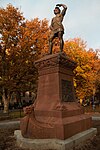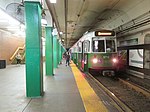Storrow Drive

Storrow Drive, officially James Jackson Storrow Memorial Drive, is a major crosstown parkway in Boston, Massachusetts, running east–west along the southern bank of the Charles River. It is restricted to cars; trucks and buses are not permitted on it, while pedestrian access is available via walking paths on the Charles River side of the road. Boston drivers use the route for quick access to downtown locations.The parkway is named for James J. Storrow, an investment banker who led a campaign to create the Charles River Basin and preserve and improve the riverbanks as a public park. He had never advocated a parkway beside the river, and his widow publicly opposed it.
Excerpt from the Wikipedia article Storrow Drive (License: CC BY-SA 3.0, Authors, Images).Storrow Drive
Dr. Paul Dudley White Path, Boston Back Bay
Geographical coordinates (GPS) Address Website Nearby Places Show on map
Geographical coordinates (GPS)
| Latitude | Longitude |
|---|---|
| N 42.352222222222 ° | E -71.088611111111 ° |
Address
Miriam & Sidney Stoneman Playground
Dr. Paul Dudley White Path
02215 Boston, Back Bay
Massachusetts, United States
Open on Google Maps










